Advancing Forensics with the Spectrum CE System
By Shannon Sinderman • January 02, 2024
Introduction to the Spectrum CE System
In the ever-evolving landscape of scientific research and discovery, current tools and methodologies can often fall short when tackling intricate problems and novel breakthroughs. Thus, the dynamic nature of scientific advancement calls for ongoing investments of both time and resources into the creation of innovative technologies. For Promega, bridging a gap in current scientific tools, pushing the boundaries of what is possible, and creating something user friendly were all major goals for the creation of the Spectrum CE System.
Mary Friedli Malone, a Senior Instrumentation Scientist at Promega, emphasizes, “The goal was always the same. We wanted to provide customers with the best possible system we could. We wanted our system to be robust and reliable with extra features to help customers with their workflow.”
The Spectrum CE System offered by Promega is an automated 8-capillary electrophoresis (CE) instrument designed to separate and detect fluorescently labeled DNA fragments, including short tandem repeat (STR) markers. The Spectrum CE System was the first CE system to support PowerPlex® 8-dye STR systems, while also maintaining compatibility with 5- and 6- color kits.
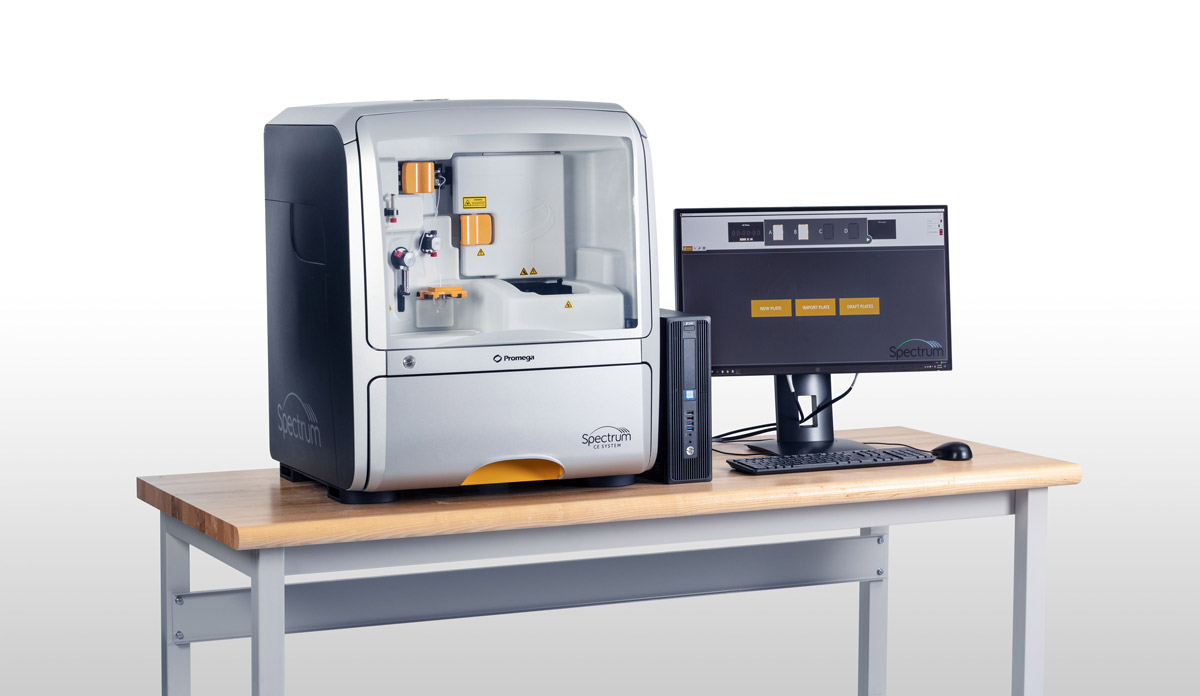
The Spectrum CE System includes a capillary electrophoresis instrument, desktop computer, monitor and consumables.
With the 8-dye chemistry, the Spectrum CE System can amplify and detect more loci, provide more meaningful analyses, and produce more consistent results from variable database and reference samples. In Friedli Malone’s words, “The Spectrum CE System and the new 8-color chemistry will be better at analyzing difficult or degraded casework samples to provide better answers for forensic laboratories”.
By pushing the limits of CE innovation, Promega has increased the potential and capabilities of DNA analysis for forensics and databasing.
“We wanted to provide customers with the best possible system we could.”
Idea Conception
Often, scientists are acutely aware of methodologies and technological obstacles that hinder the progression of their research and the uncovering of novel discoveries. The quest for a solution to these challenges is often the primary catalyst in the development of novel technologies like the Spectrum CE system.
In the field of forensics, environmental conditions like mass disasters or situations involving missing persons can often lead to the degradation of human DNA samples. Challenging samples such as these frequently result in incomplete or no STR profiles due to “drop outs” from larger loci, consequently limiting the amount of data that can extracted from these samples .
To aid with these challenging analyses, Promega aimed to create a CE system that would support 8-color chemistry, shifting the largest markers from traditional 6-dye multiplexes into two additional dye channels. According to Lisa Misner, the Training Development and Technical Support Manager for Genetic Identity at Promega, “Having the ability to expand to 8-color allows DNA typing kits to be reconfigured in a way that allows analysts to get more information from their most challenging samples—ones like mixtures and degraded samples—would make a huge impact in the forensic field.” Ultimately, by narrowing the range of autosomal amplicon lengths, it would enable amplification and detection of more loci, allowing for increased consistency and more meaningful analyses.
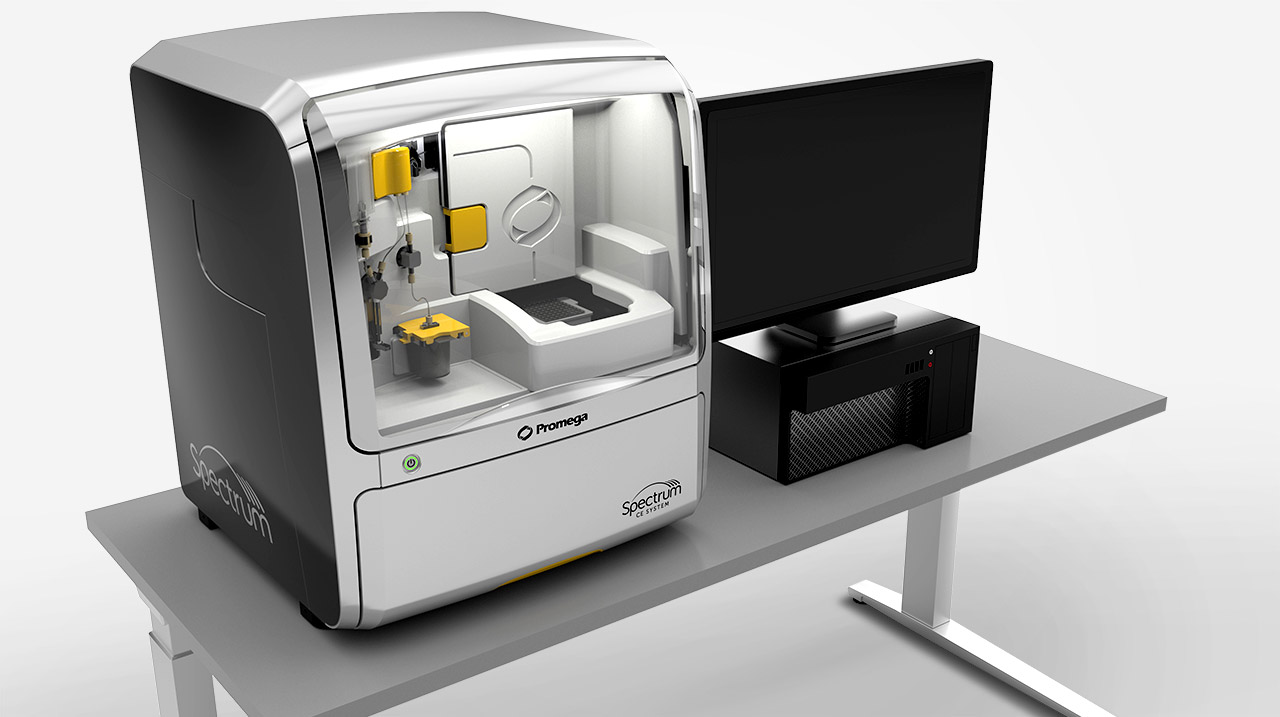
The Spectrum CE System is the first CE instrument compatible with 8-color chemistry compatible, providing easier analysis of degraded or inhibited samples.
Another obstacle in the context of CE was batch processing. Promega realized that by developing a system allowing separation of plate access from electrophoresis, the instrument’s daily use could be optimized. This approach could enhance flexibility while still upholding productivity levels when processing and prioritizing samples.
Finally, after some valuable market research, Promega was able to recognize the need for consumer choice in the CE market. According to Misner, “When this project started, there was only one option for capillary electrophoresis in the forensic DNA space. Being able to provide an alternative and having that instrument be designed with the forensic DNA analyst in mind was exciting.”
By tackling these challenges and incorporating their solutions into an innovative CE system, Promega aspired to unlock previously unattainable possibilities and push the limits of scientific exploration for forensic scientists.
Collaboration in Research and Design
Misner stated, “The best part of this project was the people working on it from departments across the company. The collaboration and teamwork are what really made this project, and that continues today as we’ve moved into supporting the product into the field.”
The research and design process is often considered the cornerstone of any developmental advancement, bridging the gap between concept and a tangible blueprint for a product. During this step, many iterations of the system are usually produced, making sure that the plan is efficient and practical while applying cutting-edge concepts, scientific principles, and considering existing technology. An in-depth design and final refinement often depend on collaboration among a multitude of specialists with various viewpoints and professions, to ensure practicality of the concept and alignment with the overarching scientific goal.
This approach was exemplified in a statement by Misner. “Initially, my role was to provide insight and feedback on design and function based on my prior experience as a forensic DNA analyst. There are a few of us here at Promega, me included, who have prior experience working in forensic DNA laboratories. We also interviewed several of our forensic customers.” With this, the team was able to discuss considerations for optimizations, enhancements, materials, component integrations, and ergonomic design to create a fine-tuned Spectrum CE system focused on being user friendly and intuitive.
With this deep understanding of the day-to-day challenges faced by forensic analysts, Promega was able to consider design elements like the continuously accessible 4-plate drawer, which eliminated scheduling and batching issues, and a vertical door for easy access to consumables. Further reflecting also gave way to ideas around maintaining backward compatibility with other chemistries, allowing analysts to choose what best suits their laboratory without being locked in by a purchasing decision. That is why Promega ensured compatibility with both the latest 8-dye technology and existing 5- and 6-color STR kits—including those from competing brands.
Friedli Malone agrees. “There were very few options for CE instruments in the market, so providing customers with another option was key. We also needed the instrument to be compatible with our current chemistries as well as our competitors’ chemistries and our new 8-color chemistry.”
Overall, by compiling a multitude of different, multidisciplinary insights for the core team behind the Spectrum CE System, the possibilities seemed endless on how Spectrum CE could transform the industry.
“The best part of this project was the people working on it from departments across the company.”
Prototyping and Construction
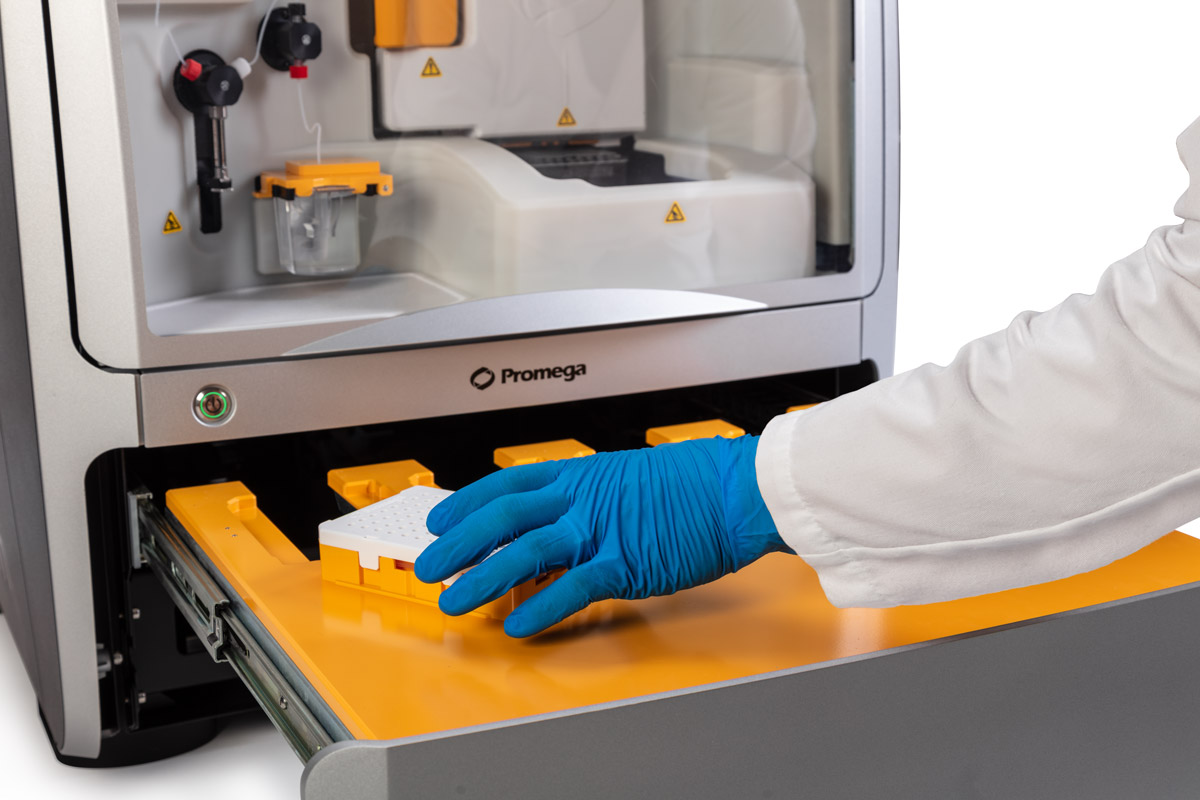
The Spectrum CE System contains a drawer that allows for easy access when inserting up to four 96-well sample plates.
After a solid theoretical concept for the Spectrum CE system was produced, the project transitioned into prototyping and construction. During this stage, a blueprint takes a tangible shape, focused on integrating complex components into a cohesive system that executes the specifications and end goals decided during earlier discussions in research and design. For the Spectrum CE System, considerations were taken not only to create a machine that aids with degraded or inhibited samples, but also to ensure the product was as user friendly as possible.
According to Friedli Malone, “People always tell us the plate drawer is the most awesome thing about the instrument. I find that funny because I am thinking, ‘Really, a drawer? What about the user-friendly software or the fact that it can run our brand new 8-color chemistry?’ Considering the way labs use these types of instruments, I understand why they think the drawer is the best part. The instrument can hold four plates at a time in the drawer, and plates can be added and removed while the instrument is running, which provides extra flexibility for laboratories.”
Putting earlier ideation to fruition, the Spectrum CE system was engineered to accommodate up to four 96-well plates, improving workflow efficiency and doubling throughput. Additionally, the separate plate access, distinct from the electrophoresis process, ensures uninterrupted access to plates not currently undergoing injection. This enables the system to run partial plates and add samples from a new plate during an ongoing run. Moreover, the vertically opening door enhances access to consumables without the risk of disrupting the workspace, meaning both the drawer and vertical door contribute to increased time and space for the laboratory. But what about the user-friendly software that Friedli Malone mentioned?
The intuitive user interface offers automatic recording of plate bar codes, making importing sample names and information a one-click process with less room for error. This property, along with clear, easy-to-comprehend display features—including run setup, consumable use information and system maintenance reminders—make the system extremely user friendly. In addition, the program reduces user intervention up to 25% by automatically correcting for most chemistry errors. It incorporates an “expert system” for precise STR sizing and allele calling, for both user-mediated and fully automated expert system analysis approaches.
The prototype itself was a huge undertaking. The team made sure to create a system that is easy to operate, compatible with other kits, able to tame challenging samples, saves space and time, and adds flexibility to sample workflows. This stage, along with all others, was a testament to the Promega team’s ingenuity, skill, and commitment to the advancement of science.
“People always tell us the plate drawer is the most awesome thing about the instrument.”
Testing and Challenges
When creating the initial specifications for the project, the wealth of perspectives employed initially helped in decreasing the amount of performance bottlenecks and unforeseen challenges, but any project has room for unanticipated obstacles.
“Of course, there were roadblocks, many of them. Sometimes we changed the experiment or design, sometimes we compromised, sometimes we had to abandon things. But what I can say about the roadblocks we did have is that I am proud of the way that everyone came together to overcome them,” Friedli Malone says.
When developing cutting-edge technology, there can often be the introduction of complexities and uncertainties that cannot be accounted for during research and design. Sometimes, these obstacles aren’t even related to the system itself; instead, they stem from external disruptions in everyday life.
“Since our team joined the project, we moved labs at least four times, with construction going on around us a couple of times,” Friedli Malone says. “I remember having to move labs so they could start construction and rolling all of our Spectrum units down the sidewalk to the other lab. One of the instruments was even running at the time!” This quirky hurdle clearly didn’t deter the Promega team; rather, it highlighted their remarkable determination to keep the project moving—albeit slowly and carefully down the sidewalk for a brief stretch.
As the project moved forward through prototyping and development, a battery of tests were necessary to identify the feasibility of the original design, validate the systems capabilities and identify any flaws or weaknesses under various conditions. This often falls to the research and development department. Friedli Malone says, “Our role was to design experiments and test the instrument throughout development, troubleshoot issues, and provide feedback to software, engineering, and operations to help make sure the instrument could meet the requirements set out in the project.” Testing these scenarios provides more information to those who need to create solutions to system issues. The more information, the better.
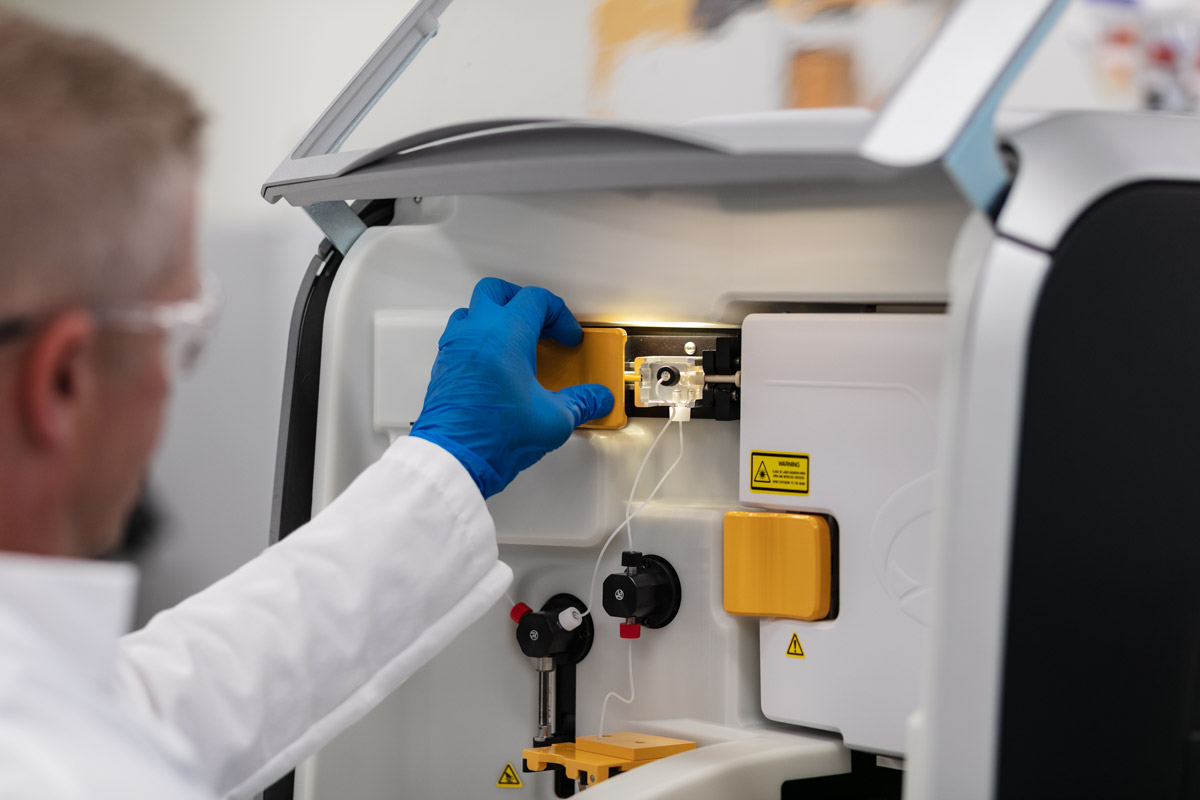
Testing and verifying the inner workings of the Spectrum CE System, by adjusting parameters and consumables.
Though the testing can be rigorous and painstaking, the end goal is always the same: to make sure the system is optimized and performs appropriately for the customer.
This is why Promega conducted a final round of testing. Misner says, “We invited some of our forensic customers here to Madison to test out early versions of the instrument and provide us with feedback.” This approach provided real-world testing scenarios that involved the customers’ needs and wants, and it anticipated possible issues that could arise. This necessary step is what allowed the product to become what it is today and impact a multitude of diverse groups, including “crime laboratories, assisting in paternity cases, missing persons and unknown remains,” Michael Lauck, a Senior Research Scientist two at Promega, says.
As a company, Promega was determined to create a new Spectrum CE system that enhanced knowledge and discovery, no matter what obstacles or barriers they encountered.

The Spectrum CE System is a reliable tool for forensic laboratories to help them process samples and eventually solve criminal cases.
“I am proud of the way that everyone came together to overcome [roadblocks].”
Launching the Spectrum CE System
Though the path taken to develop the Spectrum CE System was not without its share of obstacles, the final product and perseverance by Promega personnel exemplified the company’s unwavering determination and commitment to progress in the scientific field. The creation of the Spectrum CE System involved so many hard-working individuals at Promega, and it was a groundbreaking product to launch. To this day, the project impacts multiple people at Promega and evokes fond memories. As Friedli Malone explains, “My favorite part of the project was working with people from so many different groups and, now that Spectrum is launched, getting to work with the global team and customers.”
Beyond the excitement Promega felt at the launch, the product represents an innovative achievement that resonated across the scientific community, revolutionizing forensic casework, among other applications. The instrument empowers scientists with new capabilities, thanks to the 8-dye support, and it will further inspire the development of novel materials and products here at Promega and around the world.
Learn More
The Spectrum CE System is designed to give forensic analysts the freedom to get more done.
Related Resources
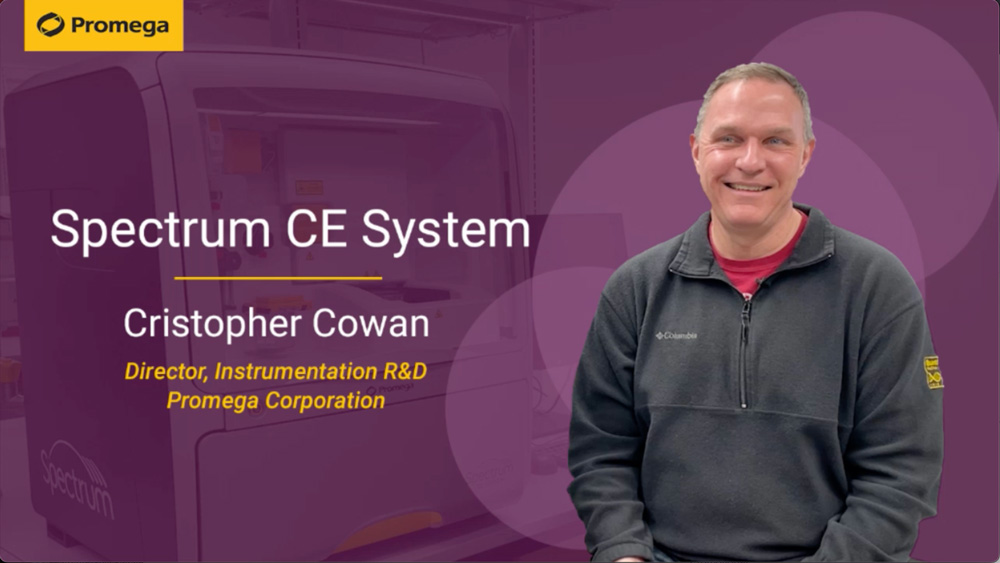
Development of the Spectrum CE System
Watch a video interview with Cris Cowan, Director of Instrumentation R&D.
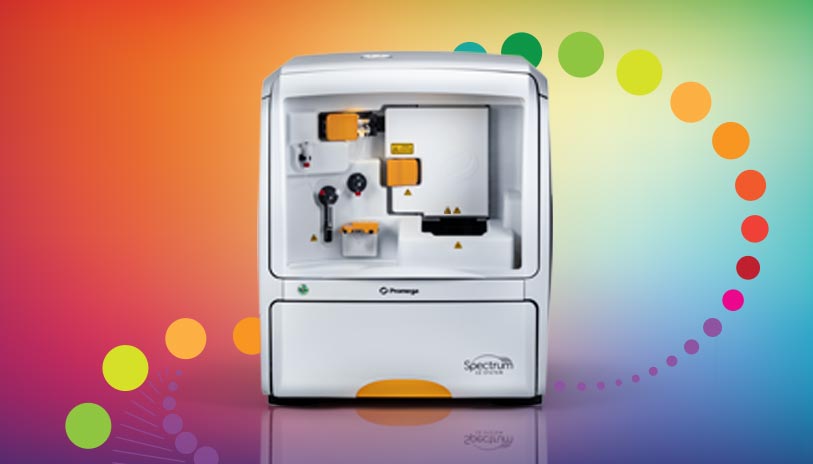
Spectrum CE System and 8-Color STR Technology
This webinar discusses how the Spectrum CE and 8-color PowerPlex® STR Systems can generate searchable profiles from degraded or inhibited casework samples.
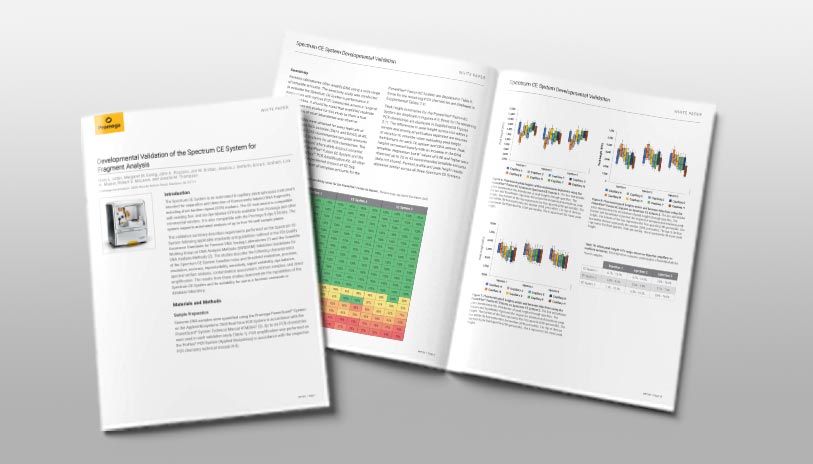
Developmental Validation of the Spectrum CE System
This white paper summarizes experiments performed according to standard guidelines to validate performance of the Spectrum CE System.